Water base Varnish/Water base coating is abbreviated as waterborne varnish or water oil, and is used for full coating or spot coating. In print, it can protect prints and enhance gloss. The advantages are non-toxicity, no environmental pollution, no solvent evaporation (low residual odor), can improve the production environment and benefit the operator's health; and can meet the environmental protection import standards of Europe and the United States. Waterborne varnish is fast, strong in abrasion resistance, hard to yellow, and high in gloss, widely used in all types of paper. Specially formulated water-based varnish can be commonly used for non-absorbent materials such as: gold, silver, PET, PP, PVC, etc.
Waterborne varnish generally consists of 80-90% aqueous resin and 10-20% of other additives. After application of the gloss, a thin layer of polymer is left on the surface of the substrate, giving the coating different properties due to the different formulation combinations. Such as high light, matte, abrasion resistance and so on.
Waterborne resin is the most important component in waterborne varnish. It determines and affects the properties of waterborne gloss oils, such as gloss, adhesion, abrasion resistance, and drying properties. Therefore, the proper choice of waterborne resin is the key to successful deployment of waterborne gloss oils.
There are many types of resins, such as waterborne rosin modified maleic resin, waterborne polyurethane resin, waterborne acrylic resin, waterborne alkyd resin, waterborne amino resin, and the like. For waterborne varnish, the selected resin should have the characteristics of easy to dissolve salt, good water release, good gloss after film formation, good heat resistance, good chemical resistance, and fast drying speed, while waterborne acrylic copolymer resin It can meet the requirements of printing glazing to the utmost, so when the water-based gloss oil is formulated, the copolymer resin of water-based acrylic system becomes our best choice.
Waterborne acrylic copolymer resins can be divided into aqueous acrylic resin solutions, aqueous acrylic dispersions, and acrylic emulsions. Acrylic emulsions can be divided into film-forming acrylic emulsions and non-film-forming acrylic emulsions. The properties of waterborne acrylic copolymer resins are composed of monomers. The performance and the synthetic process have different effects. Some monomers improve gloss and hardness, while others provide chemical resistance and adhesion. A large number of experiments have proved that the waterborne acrylic oil and acrylic emulsion are selected, and the properties of the waterborne varnish obtained through scientific compounding are all ideal.
Other additives also play an important role in the improvement and improvement of the performance of waterborne varnish. Such as leveling agents, wetting agents, defoamers, anti-wear agents. The leveling agent is to improve the fluidity, prolong the leveling time, and help the coating to form a smooth coating film after drying, so as to avoid the phenomenon of water lines and streaks. The wetting agent mainly reduces the surface tension of the waterborne varnish system and improves the wetting ability of the coating on the surface of the substrate. Defoamers can just suppress and eliminate foaming of waterborne varnish in the circulatory system and prevent excessive foam from affecting operation. Anti-wear agents can improve the anti-friction, anti-scratch and smoothness of waterborne varnish. In addition, adding a small amount of auxiliary solvent in the formulation can make the components of the waterborne varnish better miscible with each other, reduce the cohesion of the system, and improve the glossability.
Waterborne varnish is suitable for special online light units, offline roller coating machine, flexo coating, gravure coating, etc., and the pre-application is mainly connected light (such as KBA104, KBA105), offline The roller is painted. In particular, the use of online light, in addition to less or no dusting, can significantly increase printing efficiency (reducing the number of partitions) and reduce the time required for post-processing. After the light on the line is generally printed in 2 to 6 hours after die-cutting and other post-processing.
However, no matter which way you choose to polish, if you want to achieve satisfactory results. Must master the use of water-based gloss oil. Therefore, during the use of waterborne varnish, we recommend that you carefully grasp the following three factors:
1) Coating amount: After the uniform and appropriate coating is formed, the gloss is good and the abrasion resistance is high. If the coating amount is small, the waterborne varnish cannot form a complete and continuous coating film, resulting in a poor gloss, which does not provide the desired protection and decoration effects. However, if the coating amount is large, the coating thickness will increase the cost of coating, and at the same time, it will also affect the drying speed. In severe cases, sticking back will occur. We generally recommend wet coating at 4 to 10 g/m2. The specific coating amount requires the customer to make a difference depending on the characteristics of paper and equipment.
2) Viscosity: The upper machine viscosity of the offline roller is generally recommended to be 18-25 seconds (DIN4, 25°C). The lightness of the line (such as Roland 705) is generally recommended to be 40 to 70 seconds (DIN4, 25°C). If the viscosity is too low, the function of protection and decoration will not be achieved; if the viscosity is high, poor leveling and slow drying may occur. Water-based varnish and thinners are generally water, and a mixture of isopropanol:water 1:1 may also be used as a thinner, depending on the circumstances. Specific viscosity should be adjusted according to the characteristics of paper and equipment.
3) Drying temperature and time: Water-based gloss oil mainly depends on osmotic drying and cross-link curing. Common drying devices are hot air drying and infrared drying. It is generally believed that the infrared drying effect is best. The main solvent for waterborne varnish is water, and the fluidization heat of water is relatively high, so the drying speed is slower than that of oiliness. For the same reason, the drying temperature is higher than that of oily varnish. Generally recommended at 80 ~ 100 °C, drying tunnel in about 2m. If the temperature is not enough, if the drying path is too short, the coating film will not dry, and sticking and wiping will occur seriously. However, if the temperature is too high and the drying time is long, the paper fibers will lose water, the paper will become brittle, and it will be easy to Breaks and bursts occur during processing.
The above is only a brief description of the three key issues in the use of waterborne varnish, but the use of waterborne varnish is also based on different printing methods, printing equipment, paper type, ink characteristics and glazing equipment to consider comprehensively, in order to make waterborne varnish The excellence is shown.
Waterborne varnish has gradually replaced solvent-based varnish and oil varnish because of its advantages of environmental protection and ease of use. In the days to come, it will inevitably be used by more and more printers.
Author: Yung Wei Reprinted from: Graphic Arts
Lanyard
1.What is lanyard:
A lanyard is a cord or strap that is worn around the neck to hold an identification badge, whistle, keys or other small object. You can see lanyards in use everywhere by businesses, schools, hospitals, at special events, conventions, reunions, and in many recreationall activities.
2.Lanyard Category:
Based on different material used for lanyard production, here are five kinds of Zipper: Heat Transfer Lanyard , Silk-Screen Lanyard , Silicone Lanyard, Zipper Lanyard and Jacquard Lanyard.
2.1. Heat Transfer Lanyard
Sublimation Lanyard is designed in the pattern, production copperplate, electric carving through the mechanical sub-color pattern engraved on copperplate. Copperplate printing machine and then get on the pattern printed on the PET film, and then through the mechanical heat transfer lanyard pattern is transferred to the product.
Sublimation lanyard content can be product brands, publicity posters, slogans, may also be sporting events, concerts, commercial activities, the name and other gatherings LOGO. Nylon, cotton, bamboo fiber can not withstand high temperatures, and high cost to go through a special process to heat transfer lanyard.Such as custom printed lanyard,double hook lanyard.
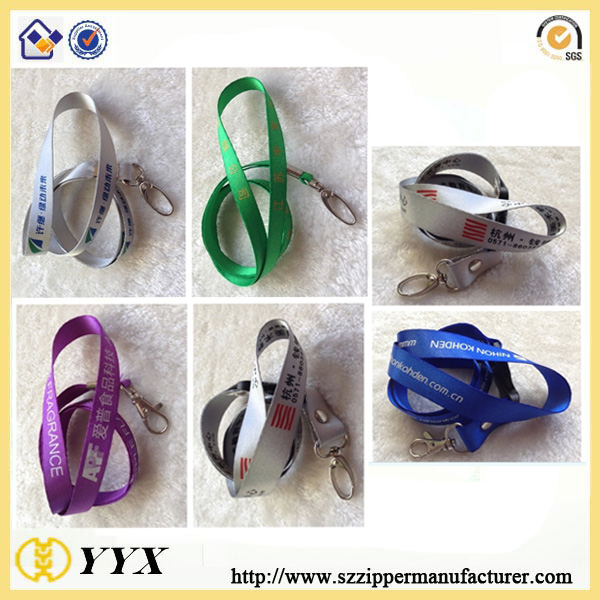
2.2. Silk-Screen Lanyard
Silk webbing lanyard is the production process LOGO traditional common expression, LOGO is printing ink by screen printing on the surface of the webbing. Printing out of LOGO texture clear, strong sense of three-dimensional, high definition, good adhesion.
Generally can be divided into screen printing lanyard phone lanyard, U disk lanyard, MP3 lanyard, working lanyard, lanyard exhibition, documents cards sling, brand badge lanyard, badge lanyard, lanyard visit visitors Wait. Product brands, publicity posters, slogans, may also be sporting events, concerts, commercial activities, the name and other gatherings LOGO.
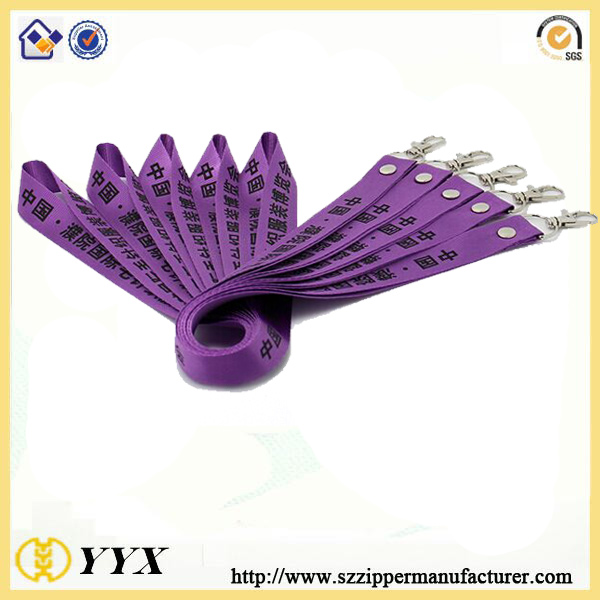
2.3. Silicone Lanyard
Silica gel is silica gel mSiO2 · nH2O made of a suitable dehydrating porous materials of different particle sizes. Has an open porous structure, specific surface area (surface area per unit mass) is large, can absorb many substances, it is a good desiccant, adsorbent and catalyst supports.
Silica gel lanyard using silica gel as a material made of, but not limited to mobile phone ornaments, can be widely used in MP3, MP4, digital cameras, small flashlights and other products of the match.
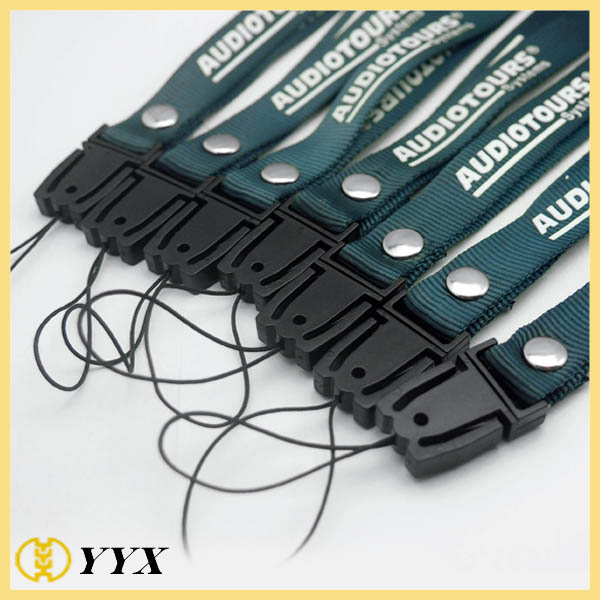
2.4. Zipper Lanyard
Zipper lanyard and zipper is shaped the same,It is the perfect companion for the mobile phone, brand certificate, key ring. Beautiful and practical zipper manufacturing plating with laser engraving and other advanced technology refined elegance applicable Peigua digital cameras MP3 U disk, PU rope, PVC rope, zipper cell phone rope, rope, harnesses, hand Wan belt.In addition to metal beads, other materials can be printed corporate LOGO logo, and in different parts and assembly methods, play publicity, promotional purposes. According to customer needs, design and manufacture many styles, diverse fashion lanyard!
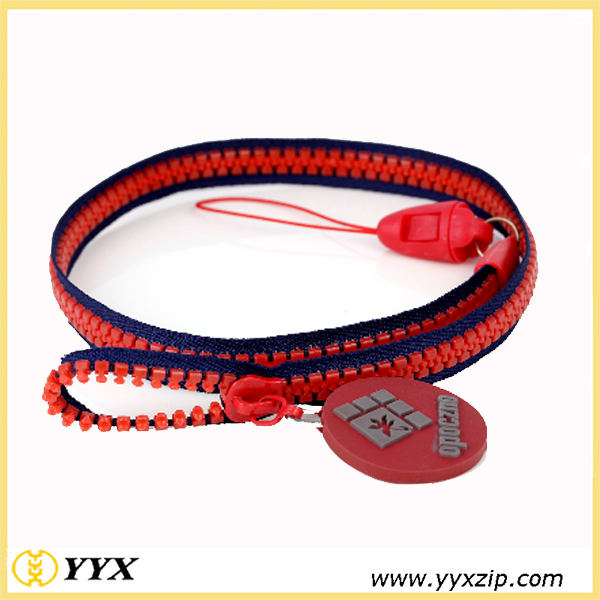
2.5. Jacquard Lanyard
Jacquard Ribbon Ribbon is a high-grade varieties.
Jacquard Ribbon generally used for high profile clothing materials or decoration materials (such as curtains, sand release material). Jacquard manufacturing process complicated. Warp and weft interwoven ups and downs, to form different patterns, convex, more weave flowers, birds, fish, insects, animals and other beautiful patterns.
Jacquard Ribbon soft, delicate, unique and smooth texture, good gloss, good drape and breathability, color fastness (yarn dyeing). Weft jacquard pattern amplitude with large and beautiful, color structured three-dimensional sense, and by the Jacquard pattern is relatively simple, relatively simple.
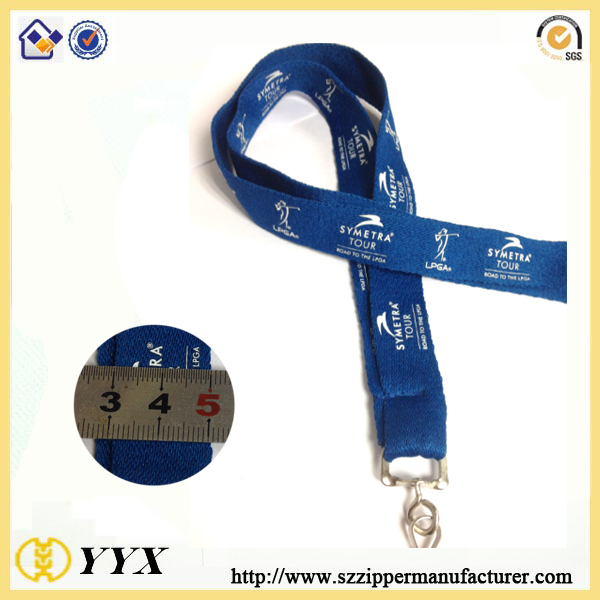
Lanyards,Custom Lanyard,Key Lanyards,Custom Lanyards,Lanyards For Keys
Shenzhen Yiyixing Zipper Manufacture Co.,Ltd , https://www.yyxchina.com